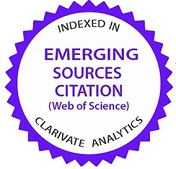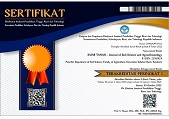Rainfall, drought, and irrigation in relation to crop patterns in the volcanic topo sequence of Central Java, Indonesia
Abstract
Keywords
Full Text:
PDFReferences
Abasi-Obot, I. E., Johnson, E. H., & Umoette, A. T. (2018). Sizing and Evaluation of Basin Irrigation Solar Water Pump for Rice Farm in Abakiliki, Ebonyi State, Nigeria. Journal of Multidisciplinary Engineering Science and Technology (JMEST), 5(11). https://www.jmest.org/wp-content/uploads/JMESTN42352767.pdf
Anderson, R., Bayer, P. E., & Edwards, D. (2020). Climate change and the need for agricultural adaptation. Current Opinion in Plant Biology, 56, 197-202. https://doi.org/10.1016/j.pbi.2019.12.006
Apriyana, Y., Surmaini, E., Estiningtyas, W., Pramudia, A., Ramadhani, F., Suciantini, S., . . . Syahbuddin, H. (2021). The Integrated Cropping Calendar Information System: A Coping Mechanism to Climate Variability for Sustainable Agriculture in Indonesia. Sustainability, 13(11), 6495. https://doi.org/10.3390/su13116495
Basuki, R. S., Khaririyatun, N., Kirana, R., Harmanto, & Thamrin, M. (2022). Farmers’ Preferences on the Quality of Indonesian Chili’s Varieties for Developing New Varieties. IOP Conference Series: Earth and Environmental Science, 995(1), 012001. https://doi.org/10.1088/1755-1315/995/1/012001
Batool, N., Shah, S. A., Dar, S. N., & Skinder, S. (2019). Rainfall variability and dynamics of cropping pattern in Kashmir Himalayas: a case study of climate change and agriculture. SN Applied Sciences, 1(6), 606. https://doi.org/10.1007/s42452-019-0599-9
Boazar, M., Abdeshahi, A., & Yazdanpanah, M. (2020). Changing rice cropping patterns among farmers as a preventive policy to protect water resources. Journal of Environmental Planning and Management, 63(14), 2484-2500. https://doi.org/10.1080/09640568.2020.1729705
Carvalho-Santos, C., Monteiro, A. T., Azevedo, J. C., Honrado, J. P., & Nunes, J. P. (2017). Climate Change Impacts on Water Resources and Reservoir Management: Uncertainty and Adaptation for a Mountain Catchment in Northeast Portugal. Water Resources Management, 31(11), 3355-3370. https://doi.org/10.1007/s11269-017-1672-z
Chhapekar, S. S., Jaiswal, V., Ahmad, I., Gaur, R., & Ramchiary, N. (2018). Progress and Prospects in Capsicum Breeding for Biotic and Abiotic Stresses. In S. Vats (Ed.), Biotic and Abiotic Stress Tolerance in Plants (pp. 279-322). Springer Singapore. https://doi.org/10.1007/978-981-10-9029-5_11
Datta, A., Ullah, H., & Ferdous, Z. (2017). Water Management in Rice. In B. S. Chauhan, K. Jabran, & G. Mahajan (Eds.), Rice Production Worldwide (pp. 255-277). Springer International Publishing. https://doi.org/10.1007/978-3-319-47516-5_11
Djaenudin, D., Marwan, H., H., S., & Hidayat, A. (2011). Petunjuk Teknis Evaluasi Lahan Untuk Komoditas Pertanian. Balai Besar Penelitian dan Pengembangan Sumberdaya Lahan Pertanian, Badan Penelitian dan Pengembangan Pertanian.
Ejigu, Y. B., & Nigatu, H. M. (2022). Rainfall Prediction and Cropping Pattern Recommendation Using Artificial Neural Network. In M. L. Berihun, Advances of Science and Technology Cham. https://doi.org/10.1007/978-3-030-93709-6_34
Fahad, S., & Jing, W. (2018). Evaluation of Pakistani farmers’ willingness to pay for crop insurance using contingent valuation method: The case of Khyber Pakhtunkhwa province. Land Use Policy, 72, 570-577. https://doi.org/10.1016/j.landusepol.2017.12.024
Fahad, S., & Wang, J. (2020). Climate change, vulnerability, and its impacts in rural Pakistan: a review. Environmental Science and Pollution Research, 27(2), 1334-1338. https://doi.org/10.1007/s11356-019-06878-1
Fatikhunnada, A., Liyantono, Solahudin, M., Buono, A., Kato, T., & Seminar, K. B. (2020). Assessment of pre-treatment and classification methods for Java paddy field cropping pattern detection on MODIS images. Remote Sensing Applications: Society and Environment, 17, 100281. https://doi.org/10.1016/j.rsase.2019.100281
Gramlich, A., Stoll, S., Stamm, C., Walter, T., & Prasuhn, V. (2018). Effects of artificial land drainage on hydrology, nutrient and pesticide fluxes from agricultural fields – A review. Agriculture, Ecosystems & Environment, 266, 84-99. https://doi.org/10.1016/j.agee.2018.04.005
Khaitov, B., Umurzokov, M., Cho, K.-M., Lee, Y.-J., Park, K. W., & Sung, J. (2019). Importance and production of chilli pepper; heat tolerance and efficient nutrient use under climate change conditions. Korean Journal of Agricultural Science, 46(4), 769-779. https://koreascience.kr/article/JAKO201907963545993.pdf
Kogo, B. K., Kumar, L., & Koech, R. (2021). Climate change and variability in Kenya: a review of impacts on agriculture and food security. Environment, Development and Sustainability, 23(1), 23-43. https://doi.org/10.1007/s10668-020-00589-1
Komariah, Senge, M., Sumani, Dewi, W. S., Yoshiyama, K., & Rachmadiyanto, A. N. (2015). The impacts of decreasing paddy field area on local climate in central java, Indonesia. Air, Soil and Water Research, 8, ASWR. S21560. https://doi.org/10.1177/ASWR.S21560
Kumar, R., Rawat, K., & Yadav, B. (2012). Vertical distribution of physico-chemical properties under different topo-sequence in soils of Jharkhand. Journal of Agricultural Physics, 12(1), 63-69. https://www.agrophysics.in/admin/adminjournalpdf/2018121415375328549094/journal-919063799.pdf
Kusumo, B. B., Pranoto, S. A., & Sriyana, I. (2019). Study of Intermittent-Irrigation Technique to Cropping Patterns and Water Availability at Pemali Kanan Irrigation Area in Brebes Regency. IOP Conference Series: Earth and Environmental Science, 328(1), 012011. https://doi.org/10.1088/1755-1315/328/1/012011
Kyei-Mensah, C., Kyerematen, R., & Adu-Acheampong, S. (2019). Impact of Rainfall Variability on Crop Production within the Worobong Ecological Area of Fanteakwa District, Ghana. Advances in Agriculture, 2019(1), 7930127. https://doi.org/10.1155/2019/7930127
Labudová, L., Labuda, M., & Takáč, J. (2017). Comparison of SPI and SPEI applicability for drought impact assessment on crop production in the Danubian Lowland and the East Slovakian Lowland. Theoretical and Applied Climatology, 128(1), 491-506. https://doi.org/10.1007/s00704-016-1870-2
Loo, Y. Y., Billa, L., & Singh, A. (2015). Effect of climate change on seasonal monsoon in Asia and its impact on the variability of monsoon rainfall in Southeast Asia. Geoscience Frontiers, 6(6), 817-823. https://doi.org/10.1016/j.gsf.2014.02.009
McKee, T. B., Doesken, N. J., & Kleist, J. (1993). The relationship of drought frequency and duration to time scales. Proceedings of the 8th Conference on Applied Climatology. https://www.droughtmanagement.info/literature/AMS_Relationship_Drought_Frequency_Duration_Time_Scales_1993.pdf
Montes, R., & Jose, J. J. S. (1995). Vegetation and soil analysis of topo-sequences in the Orinoco Llanos. Flora, 190(1), 1-33. https://doi.org/10.1016/S0367-2530(17)30622-9
Musa, Y., & Farid, M. (2018). Advanced yield potential test on synthetic genotype of maize tolerant to drought and low nitrogen. IOP Conference Series: Earth and Environmental Science, 157(1), 012016. https://doi.org/10.1088/1755-1315/157/1/012016
Nugroho, B. D. A., & Nuraini, L. (2016). Cropping Pattern Scenario based on Global Climate Indices and Rainfall in Banyumas District, Central Java, Indonesia. Agriculture and Agricultural Science Procedia, 9, 54-63. https://doi.org/10.1016/j.aaspro.2016.02.124
Oldeman, L., & Frere, M. (1982). Technical Report on a Study of the Agroclimatology of the Humid Tropics of Southeast Asia. Food & Agriculture Org.
Pinto, M. A. B., Parfitt, J. M. B., Timm, L. C., Faria, L. C., Concenço, G., Stumpf, L., & Nörenberg, B. G. (2020). Sprinkler irrigation in lowland rice: Crop yield and its components as a function of water availability in different phenological phases. Field Crops Research, 248, 107714. https://doi.org/10.1016/j.fcr.2020.107714
Pramudya, Y., & Onishi, T. (2018). Assessment of the Standardized Precipitation Index (SPI) in Tegal City, Central Java, Indonesia. IOP Conference Series: Earth and Environmental Science, 129(1), 012019. https://doi.org/10.1088/1755-1315/129/1/012019
Purnomo, J., & Rahmianna, A. A. (2020). Response of groundnut promising lines to various environments. IOP Conference Series: Earth and Environmental Science, 456(1), 012053. https://doi.org/10.1088/1755-1315/456/1/012053
Sekaranom, A. B., Fianggoro, M., & Wicaksono, R. M. (2021). Spatial Analysis of Rainfall Return Period and Probable Maximum Precipitation over Central Java - Indonesia. IOP Conference Series: Earth and Environmental Science, 819(1), 012090. https://doi.org/10.1088/1755-1315/819/1/012090
Setimela, P. S., Magorokosho, C., Lunduka, R., Gasura, E., Makumbi, D., Tarekegne, A., . . . Mwangi, W. (2017). On-Farm Yield Gains with Stress-Tolerant Maize in Eastern and Southern Africa. Agronomy Journal, 109(2), 406-417. https://doi.org/10.2134/agronj2015.0540
Shaabani, M. K., Abedi-Koupai, J., Eslamian, S. S., & Gohari, S. A. R. (2024). Simulation of the effects of climate change, crop pattern change, and developing irrigation systems on the groundwater resources by SWAT, WEAP and MODFLOW models: a case study of Fars province, Iran. Environment, Development and Sustainability, 26(4), 10485-10511. https://doi.org/10.1007/s10668-023-03157-5
Song, E. Y., Moon, K. H., Son, I. C., Wi, S. H., Kim, C. H., Lim, C. K., & Oh, S. (2015). Impact of elevating temperature based on climate change scenarios on growth and fruit quality of red pepper (Capsicum annuum L.). Korean Journal of Agricultural and Forest Meteorology, 17(3), 248-253. https://koreascience.kr/article/JAKO201530856746400.page
Sutresna, I., Aryana, I., & Gunartha, I. (2018). Evaluation of superior maize genotypes on growth environment with improved cultivation technology. IOSR Journal of Agriculture and Veterinary Science (IOSR-JAVS) V0l, 11(6), 01-04. https://www.iosrjournals.org/iosr-javs/papers/Vol11-issue6/Version-1/A1106010104.pdf
Wang, E., Cresswell, H., Paydar, Z., & Gallant, J. (2008). Opportunities for manipulating catchment water balance by changing vegetation type on a topographic sequence: a simulation study. Hydrological Processes, 22(6), 736-749. https://doi.org/10.1002/hyp.6655
Refbacks
- There are currently no refbacks.











.png)





